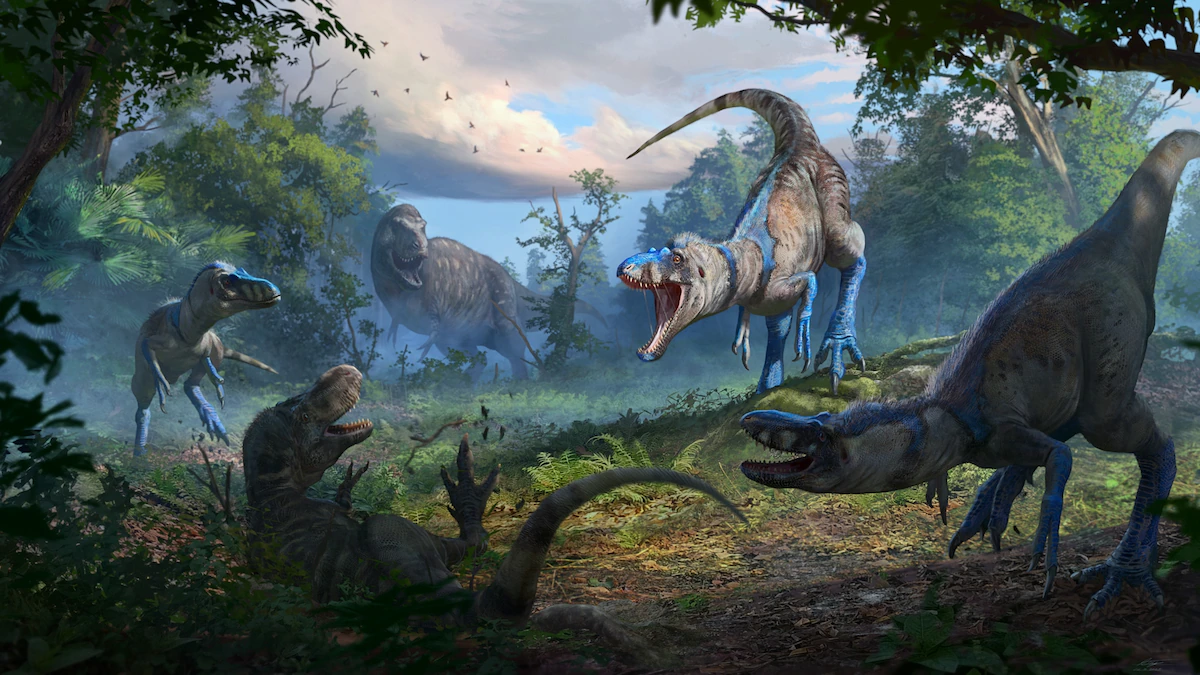Copyright National Geographic

One of paleontology’s most polarizing problems is a teenage Tyrannosaurus rex with an identity crisis, and two scientists say they’ve solved it. In 1942, researchers from the Cleveland Museum of Natural History found the skull of a small theropod in Montana’s Hell Creek Formation. After scientists classified it as the new species Nanotyrannus lancensis in 1988, the skull sparked four decades of fierce debate: Do such fossils of small and slender tyrannosaurs represent a teenage version of the fearsome T. rex, or an entirely distinct dinosaur? Now, after analyzing more than 200 tyrannosaur fossils, the authors of a new study have declared that Nanotyrannus was a swift and lean dinosaur that lived alongside T. rex in the twilight of the tyrant’s reign. They published their findings October 30 in Nature. “We did not want to contribute to fueling the fire on this debate. We wanted to shut down the debate,” says Lindsay Zanno, a paleontologist at the North Carolina Museum of Natural Sciences and co-author of the paper. “We decided to just make sure that we tested this question from every angle.” Some outside experts have praised the rigor of the study, saying that it could be an inflection point that finally settles the decades-long debate. “They left no stone unturned, no fossil unexamined,” says Lawrence Witmer, a paleontologist at Ohio University. “The outcome of their careful studies is clear and about as definitive as we can get in paleontology—Nanotyrannus is real.” LIMITED TIME OFFER Other paleontologists caution that the finding, though convincing, may just be the latest twist and turn in the Nanotyrannus saga. “Their findings, just like previous reports, present hypotheses. What seems like the answer one day can be falsified the next with new approaches or new data,” says Holly Woodward Ballard, a paleohistologist from Oklahoma State University whose previous study of tyrannosaur leg growth rates put Nanotyrannus in the T. rex category. Dueling dinosaur dilemma In 2020, the North Carolina Museum of Natural Sciences announced its acquisition of the famous 67 million-year-old “Dueling Dinosaurs” fossil. Long held in private hands, the exquisitely preserved specimen showed a Triceratops and small tyrannosaur seemingly locked in mortal combat. Some scientists thought the tyrannosaur was a young T.rex that died before it could develop into its adult form, though others believed it to be a Nanotyrannus. The acquisition brought the fossil into a museum for the first time, allowing paleontologists like Zanno better access to what was essentially a complete skeleton of this creature. She recruited James Napoli, a paleontologist at Stony Brook University on Long Island who had studied crocodilian growth and development, to help her study the specimen. ('Dueling Dinosaurs' fossil, hidden from science for 14 years, could finally reveal its secrets) When Zanno and Napoli sat down to study the fossil, “it became pretty quickly clear that there were a lot of red flags here,” says Zanno, who is also a National Geographic Explorer. There were a lot of things about the specimen that “didn't seem to fit with our expectations of how T. rex should grow, or really how any animal should grow.” The arms were a critical anatomical clue that something was amiss. They were already much larger than the arms of an adult T.rex. “There's no way that during growth, these arms were going to shrink,” says Napoli. They also found that the dinosaur had a shorter tail than T.rex has, comparatively longer legs, and more teeth in its jaws. A CT-scan also revealed that its cranial nerves and respiratory system looked different than those of T.rex; plus it had an extra sinus cavity. Those features, they said, are usually set early in development, meaning that this tyrannosaur was not on track to morph into an adult T.rex before it died. They also took thin sections of the bones to analyze its growth rings which helped indicate that it was about 20 years old and that it was mature, not a juvenile. “There is no possible way to scientifically defend calling this a T.rex,” says Napoli. Instead, they say it should indeed be labeled Nanotyrannus lancensis, the same species as the Nanotyrannus that ignited the debate when it was given that name in 1988. Woodward Ballard agreed that the researcher’s data appears to show that the specimen is approaching adult size—and that’s “strong support” for calling it Nanotyrannus, she says. But what about other specimen? A new picture of a prehistoric predator Drawing on evidence from the “Dueling Dinosaurs” fossil, Napoli and Zanno also examined tyrannosaurs held in collections in the U.S., Canada, and Asia. In total, they identified a handful of specimens that they say are Nanotyrannus, including the controversial “Jane” held in the Burpee Museum in Illinois and the Cleveland museum specimen that was named in 1988. “The debate over Nanotyrannus has raged for decades, and I think most scientists fell on the side that it was a juvenile T. rex,” says David Evans, a paleontologist from the Royal Ontario Museum. “This new study is going to surprise a lot of people. The findings suggest that Nanotyrannus was a predator roughly half the size of T.rex, and only a tenth its body mass. If T.rex—weighing 18,000 pounds and measuring more than 40 feet—was the lion of the late Cretaceous, Nanotyrannus—measuring about 1,500 pounds and 18 feet—may have been a cheetah that was built for speed rather than raw power. (New evidence reveals dinosaurs were thriving right up to the moment the asteroid hit) “From this paper forward, our field needs to proceed from the assumption as a default that Nanotyrannus is a valid species,” says Napoli. “There's a large body of research that needs to be pretty fully re-evaluated.” If confirmed, the finding could reshape what scientists know about Earth's most famous prehistoric predator and provide insight into the other carnivores that prowled the late Cretaceous landscape. The authors add that their results may also prompt a sweeping re-analysis of how T.rex grew and developed. Some leading theories, they say, were built upon the assumption that Nanotyrannus fossils represented T.rex during its awkward adolescence a notion the new research might overturn. “I'm not yet ready to proclaim every smaller tyrannosaur skeleton to be Nanotyrannus. Some of these must be juvenile T. rexes,” says Steve Brusatte, a National Geographic Explorer and a paleontologist from University of Edinburgh in Scotland who has long argued that Nanotyrannus is just a young T.rex. But he says the case for the existence of Nanotyrannus is undeniably strong. “It's wonderful when new evidence shows that some of our cherished notions—my cherished notions as a tyrannosaur researcher—are likely to be wrong,” he adds. “That's science, and with fossils, we always have to be humble with the reality that we are dealing with such small sample sizes, such meagre clues from millions of years ago, and each new discovery has the possibility of upending conventional wisdom.”



